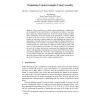Free Online Productivity Tools
i2Speak
i2Symbol
i2OCR
iTex2Img
iWeb2Print
iWeb2Shot
i2Type
iPdf2Split
iPdf2Merge
i2Bopomofo
i2Arabic
i2Style
i2Image
i2PDF
iLatex2Rtf
Sci2ools
CAV
2009
Springer
2009
Springer
Explaining Counterexamples Using Causality
Abstract. When a model does not satisfy a given specification, a counterexample is produced by the model checker to demonstrate the failure. A user must then examine the counterexample trace, in order to visually identify the failure that it demonstrates. If the trace is long, or the specification is complex, finding the failure in the trace becomes a non-trivial task. In this paper, we address the problem of analyzing a counterexample trace and highlighting the failure that it demonstrates. Using the notion of causality, introduced by Halpern and Pearl, we formally define a set of causes for the failure of the specification on the given counterexample trace. These causes are marked as red dots and presented to the user as a visual explanation of the failure. We study the complexity of computing the exact set of causes, and provide a polynomial-time algorithm that approximates it. This algorithm is implemented as a feature in the IBM formal verification platform RuleBase PE, where thes...
CAV 2009 | Counterexample Trace | Formal Methods | Light-weight External Layer | Model Checking Tool |
| Added | 25 Nov 2009 |
| Updated | 25 Nov 2009 |
| Type | Conference |
| Year | 2009 |
| Where | CAV |
| Authors | Ilan Beer, Shoham Ben-David, Hana Chockler, Avigail Orni, Richard J. Trefler |
Comments (0)

